length NISSAN TITAN 2017 2.G Owners Manual
[x] Cancel search | Manufacturer: NISSAN, Model Year: 2017, Model line: TITAN, Model: NISSAN TITAN 2017 2.GPages: 671, PDF Size: 7.96 MB
Page 46 of 671
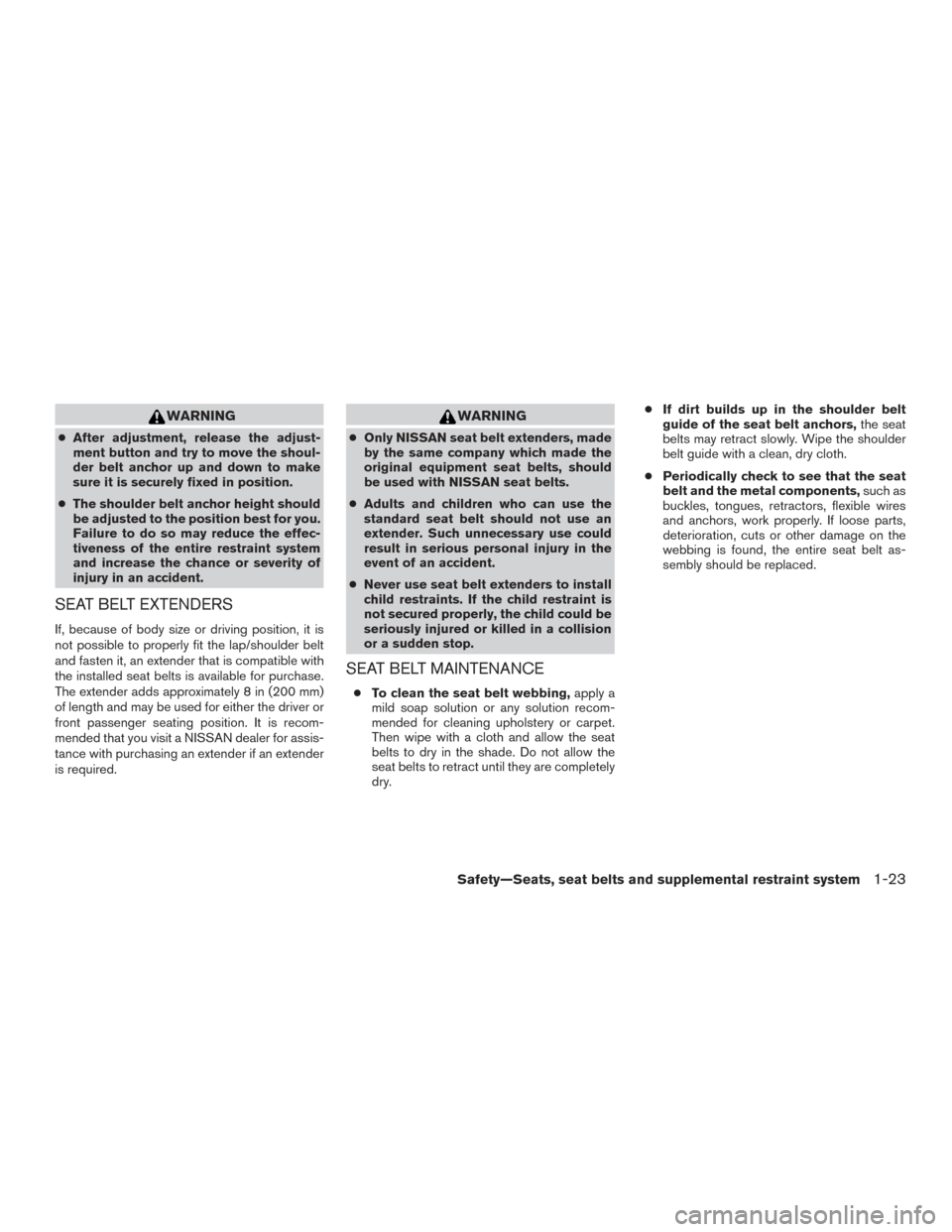
WARNING
●After adjustment, release the adjust-
ment button and try to move the shoul-
der belt anchor up and down to make
sure it is securely fixed in position.
● The shoulder belt anchor height should
be adjusted to the position best for you.
Failure to do so may reduce the effec-
tiveness of the entire restraint system
and increase the chance or severity of
injury in an accident.
SEAT BELT EXTENDERS
If, because of body size or driving position, it is
not possible to properly fit the lap/shoulder belt
and fasten it, an extender that is compatible with
the installed seat belts is available for purchase.
The extender adds approximately 8 in (200 mm)
of length and may be used for either the driver or
front passenger seating position. It is recom-
mended that you visit a NISSAN dealer for assis-
tance with purchasing an extender if an extender
is required.
WARNING
● Only NISSAN seat belt extenders, made
by the same company which made the
original equipment seat belts, should
be used with NISSAN seat belts.
● Adults and children who can use the
standard seat belt should not use an
extender. Such unnecessary use could
result in serious personal injury in the
event of an accident.
● Never use seat belt extenders to install
child restraints. If the child restraint is
not secured properly, the child could be
seriously injured or killed in a collision
or a sudden stop.
SEAT BELT MAINTENANCE
● To clean the seat belt webbing, apply a
mild soap solution or any solution recom-
mended for cleaning upholstery or carpet.
Then wipe with a cloth and allow the seat
belts to dry in the shade. Do not allow the
seat belts to retract until they are completely
dry. ●
If dirt builds up in the shoulder belt
guide of the seat belt anchors, the seat
belts may retract slowly. Wipe the shoulder
belt guide with a clean, dry cloth.
● Periodically check to see that the seat
belt and the metal components, such as
buckles, tongues, retractors, flexible wires
and anchors, work properly. If loose parts,
deterioration, cuts or other damage on the
webbing is found, the entire seat belt as-
sembly should be replaced.
Safety—Seats, seat belts and supplemental restraint system1-23
Page 379 of 671
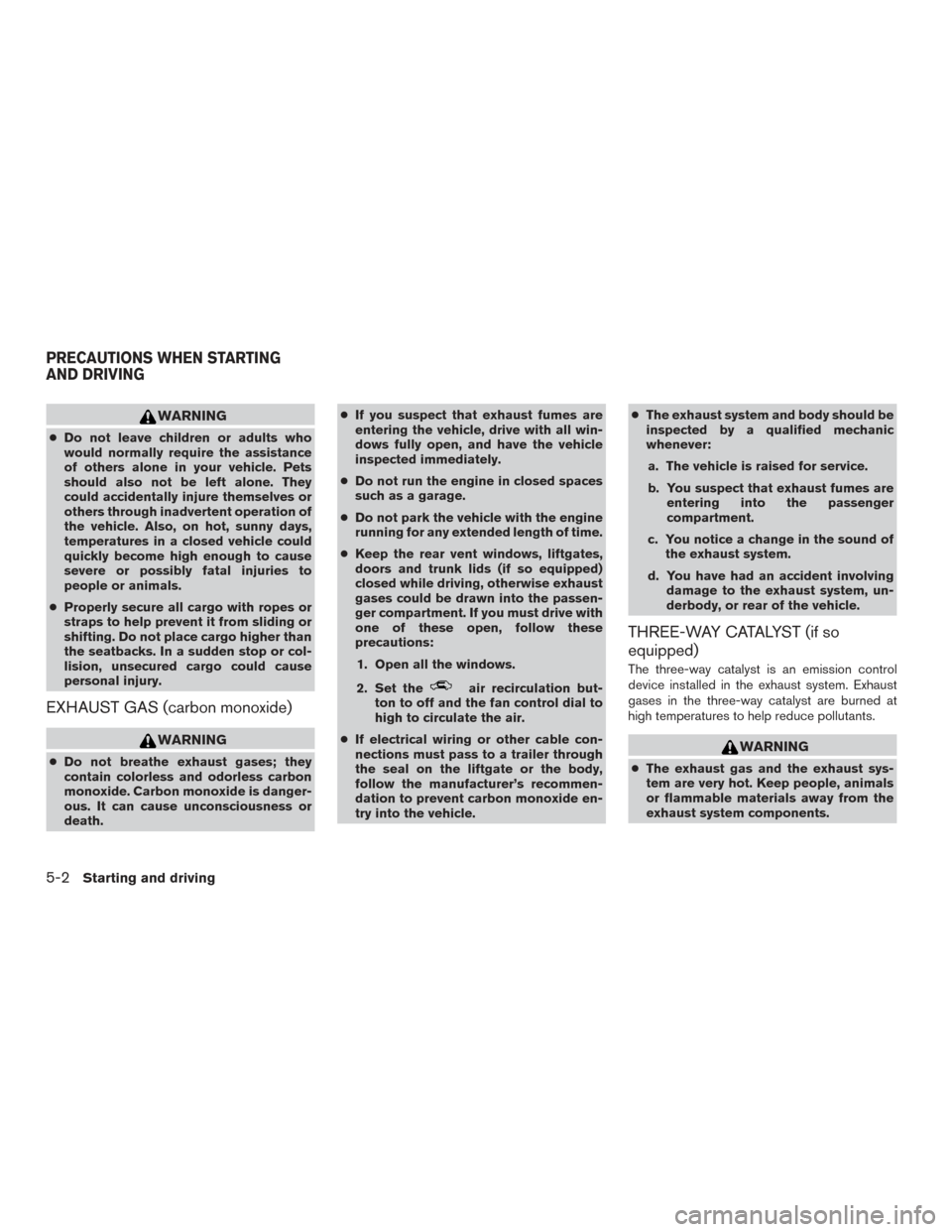
WARNING
●Do not leave children or adults who
would normally require the assistance
of others alone in your vehicle. Pets
should also not be left alone. They
could accidentally injure themselves or
others through inadvertent operation of
the vehicle. Also, on hot, sunny days,
temperatures in a closed vehicle could
quickly become high enough to cause
severe or possibly fatal injuries to
people or animals.
● Properly secure all cargo with ropes or
straps to help prevent it from sliding or
shifting. Do not place cargo higher than
the seatbacks. In a sudden stop or col-
lision, unsecured cargo could cause
personal injury.
EXHAUST GAS (carbon monoxide)
WARNING
● Do not breathe exhaust gases; they
contain colorless and odorless carbon
monoxide. Carbon monoxide is danger-
ous. It can cause unconsciousness or
death. ●
If you suspect that exhaust fumes are
entering the vehicle, drive with all win-
dows fully open, and have the vehicle
inspected immediately.
● Do not run the engine in closed spaces
such as a garage.
● Do not park the vehicle with the engine
running for any extended length of time.
● Keep the rear vent windows, liftgates,
doors and trunk lids (if so equipped)
closed while driving, otherwise exhaust
gases could be drawn into the passen-
ger compartment. If you must drive with
one of these open, follow these
precautions:
1. Open all the windows.
2. Set the
air recirculation but-
ton to off and the fan control dial to
high to circulate the air.
● If electrical wiring or other cable con-
nections must pass to a trailer through
the seal on the liftgate or the body,
follow the manufacturer’s recommen-
dation to prevent carbon monoxide en-
try into the vehicle. ●
The exhaust system and body should be
inspected by a qualified mechanic
whenever:
a. The vehicle is raised for service.
b. You suspect that exhaust fumes are entering into the passenger
compartment.
c. You notice a change in the sound of the exhaust system.
d. You have had an accident involving damage to the exhaust system, un-
derbody, or rear of the vehicle.
THREE-WAY CATALYST (if so
equipped)
The three-way catalyst is an emission control
device installed in the exhaust system. Exhaust
gases in the three-way catalyst are burned at
high temperatures to help reduce pollutants.
WARNING
●The exhaust gas and the exhaust sys-
tem are very hot. Keep people, animals
or flammable materials away from the
exhaust system components.
PRECAUTIONS WHEN STARTING
AND DRIVING
5-2Starting and driving
Page 546 of 671
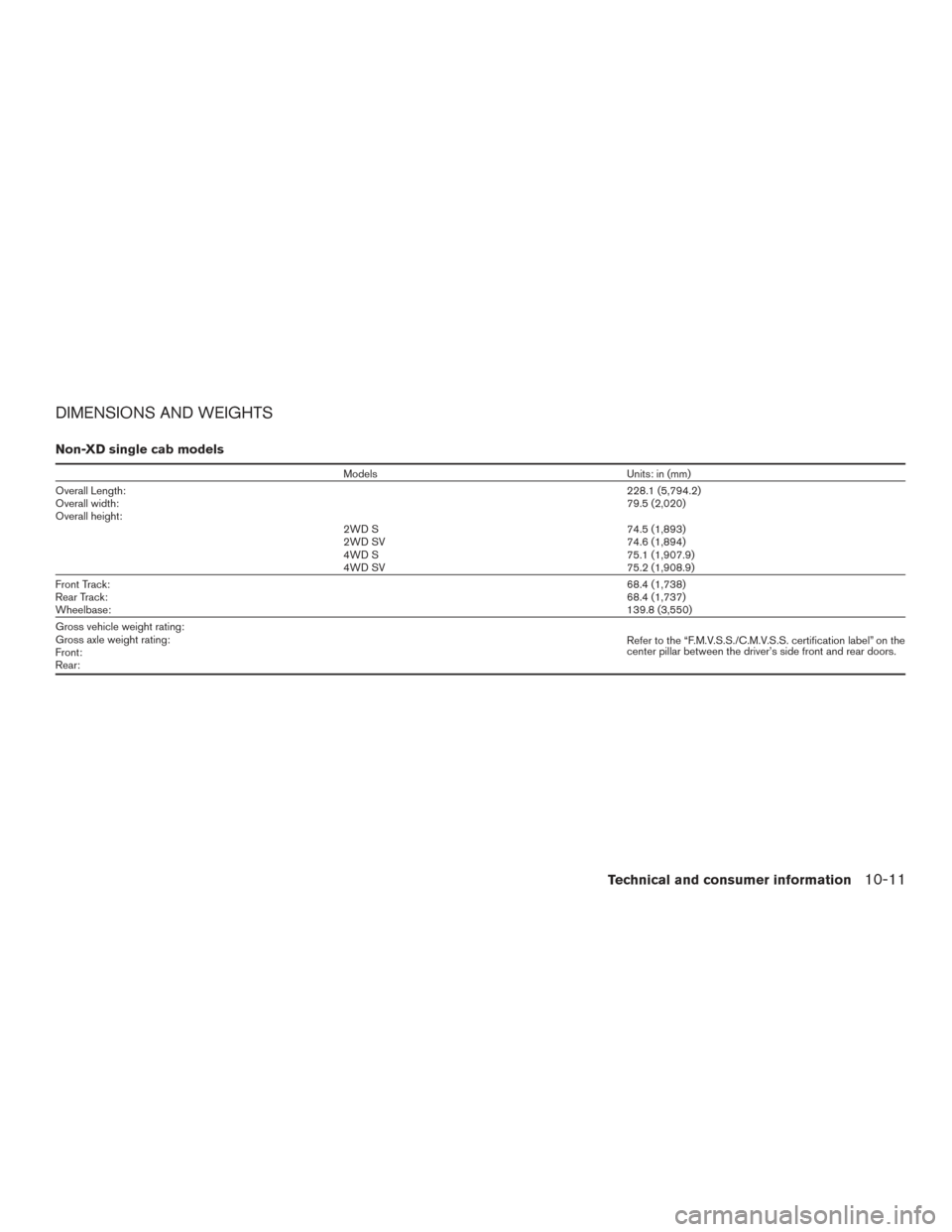
DIMENSIONS AND WEIGHTS
Non-XD single cab models
ModelsUnits: in (mm)
Overall Length: 228.1 (5,794.2)
Overall width: 79.5 (2,020)
Overall height: 2WD S74.5 (1,893)
2WD SV 74.6 (1,894)
4WD S 75.1 (1,907.9)
4WD SV 75.2 (1,908.9)
Front Track: 68.4 (1,738)
Rear Track: 68.4 (1,737)
Wheelbase: 139.8 (3,550)
Gross vehicle weight rating: Refer to the “F.M.V.S.S./C.M.V.S.S. certification label” on the
center pillar between the driver’s side front and rear doors.
Gross axle weight rating:
Front:
Rear:
Technical and consumer information10-11
Page 547 of 671
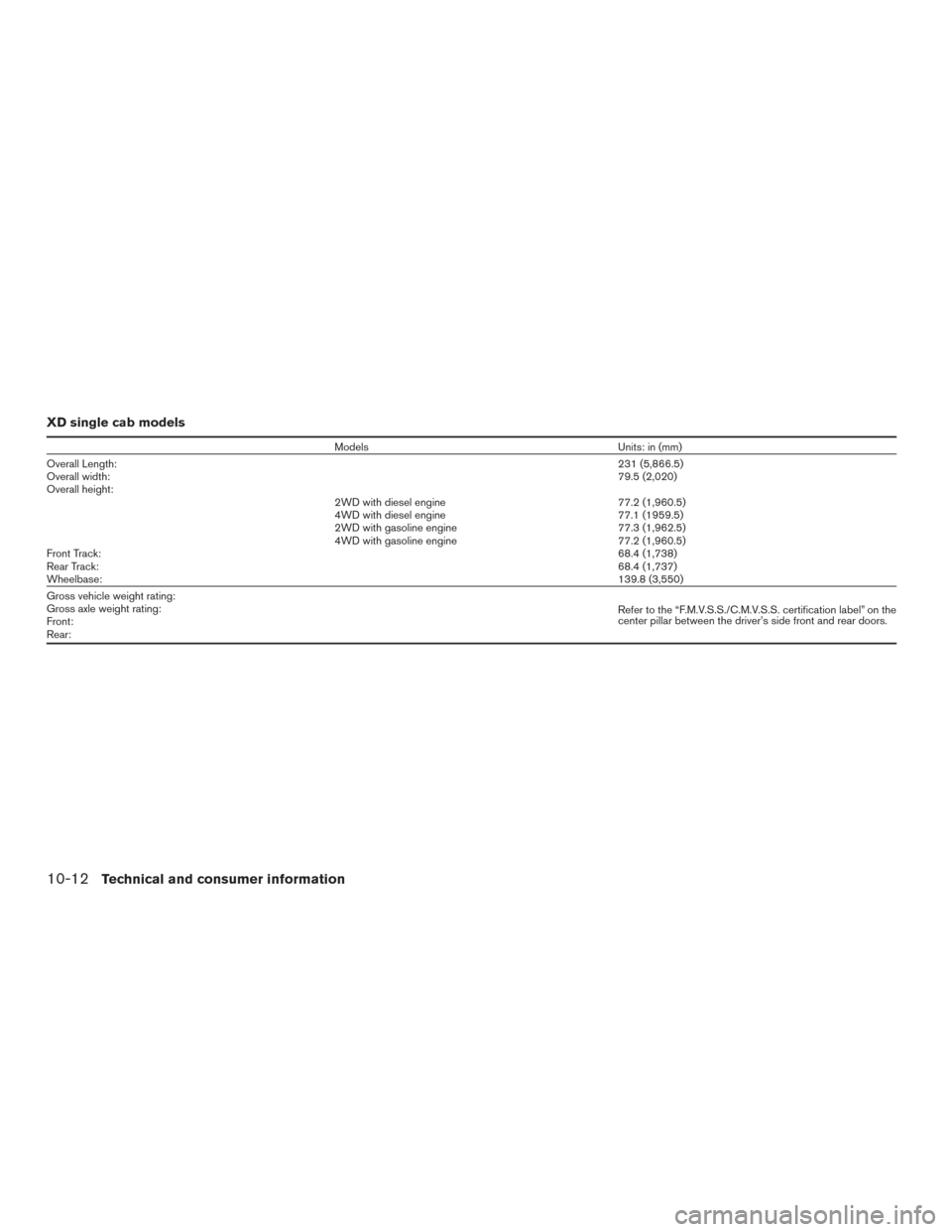
XD single cab models
ModelsUnits: in (mm)
Overall Length: 231 (5,866.5)
Overall width: 79.5 (2,020)
Overall height: 2WD with diesel engine77.2 (1,960.5)
4WD with diesel engine 77.1 (1959.5)
2WD with gasoline engine 77.3 (1,962.5)
4WD with gasoline engine 77.2 (1,960.5)
Front Track: 68.4 (1,738)
Rear Track: 68.4 (1,737)
Wheelbase: 139.8 (3,550)
Gross vehicle weight rating: Refer to the “F.M.V.S.S./C.M.V.S.S. certification label” on the
center pillar between the driver’s side front and rear doors.
Gross axle weight rating:
Front:
Rear:
10-12Technical and consumer information
Page 548 of 671
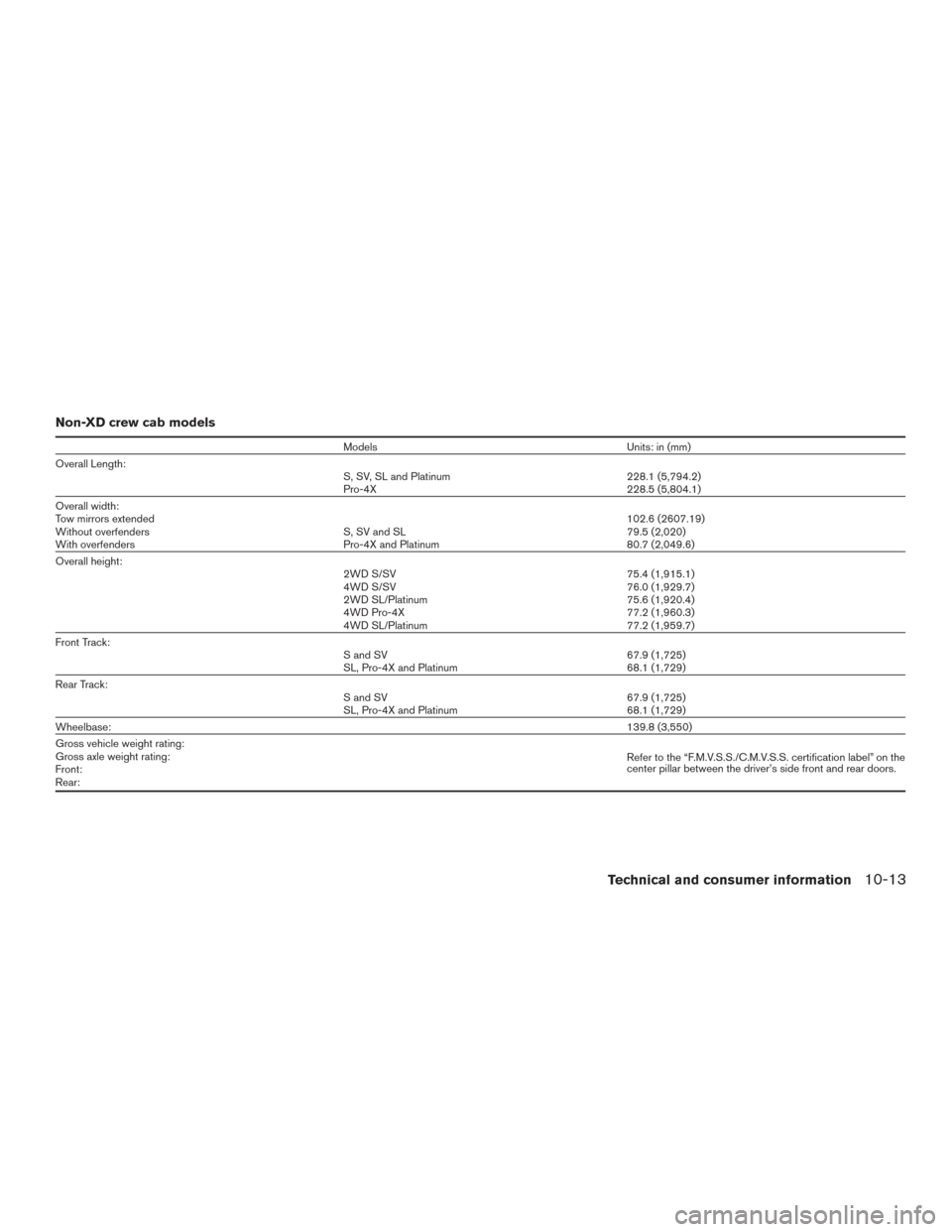
Non-XD crew cab models
ModelsUnits: in (mm)
Overall Length: S, SV, SL and Platinum228.1 (5,794.2)
Pro-4X 228.5 (5,804.1)
Overall width:
Tow mirrors extended 102.6 (2607.19)
Without overfenders S, SV and SL79.5 (2,020)
With overfenders Pro-4X and Platinum80.7 (2,049.6)
Overall height: 2WD S/SV75.4 (1,915.1)
4WD S/SV 76.0 (1,929.7)
2WD SL/Platinum 75.6 (1,920.4)
4WD Pro-4X 77.2 (1,960.3)
4WD SL/Platinum 77.2 (1,959.7)
Front Track: S and SV67.9 (1,725)
SL, Pro-4X and Platinum 68.1 (1,729)
Rear Track: S and SV67.9 (1,725)
SL, Pro-4X and Platinum 68.1 (1,729)
Wheelbase: 139.8 (3,550)
Gross vehicle weight rating: Refer to the “F.M.V.S.S./C.M.V.S.S. certification label” on the
center pillar between the driver’s side front and rear doors.
Gross axle weight rating:
Front:
Rear:
Technical and consumer information10-13
Page 549 of 671
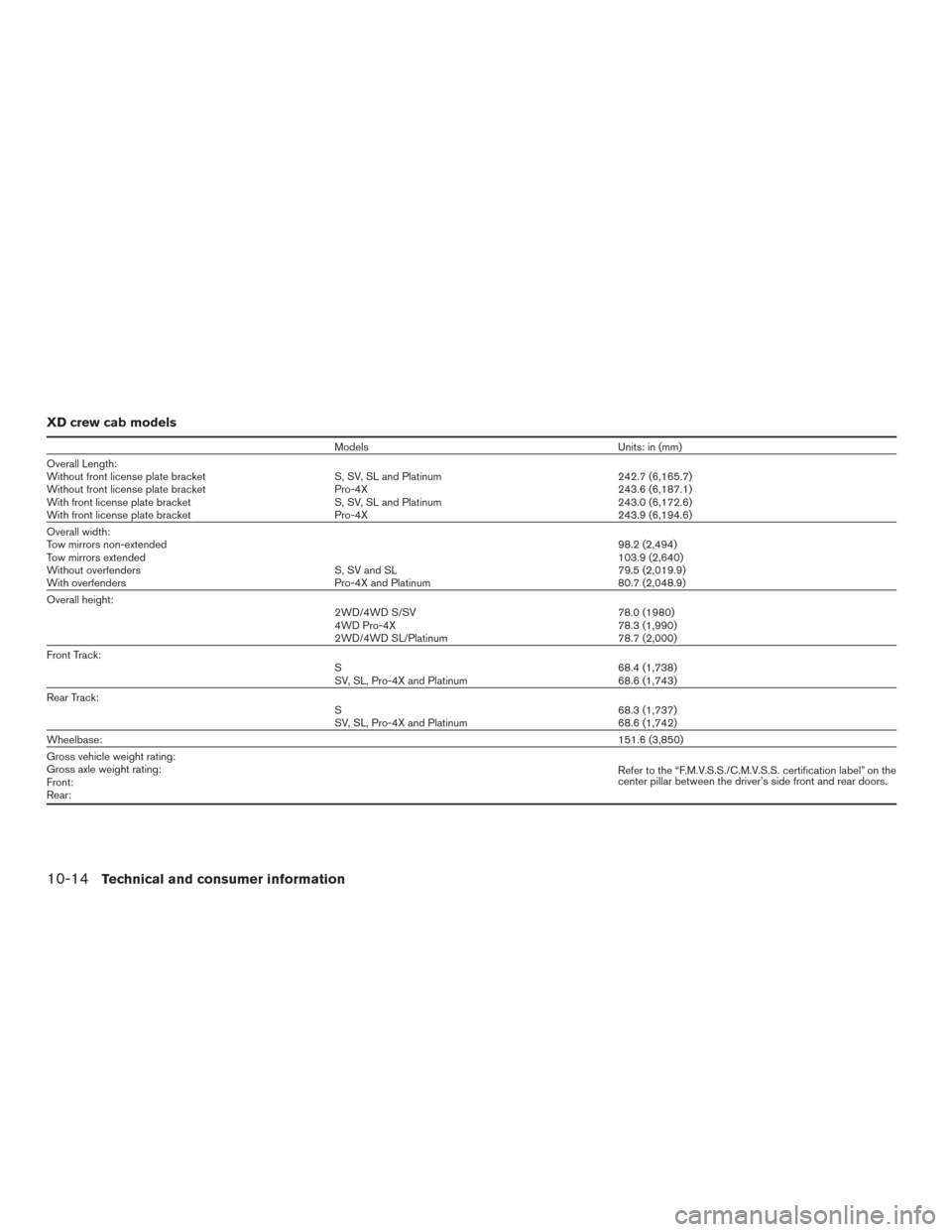
XD crew cab models
ModelsUnits: in (mm)
Overall Length:
Without front license plate bracket S, SV, SL and Platinum242.7 (6,165.7)
Without front license plate bracket Pro-4X243.6 (6,187.1)
With front license plate bracket S, SV, SL and Platinum243.0 (6,172.6)
With front license plate bracket Pro-4X243.9 (6,194.6)
Overall width:
Tow mirrors non-extended 98.2 (2,494)
Tow mirrors extended 103.9 (2,640)
Without overfenders S, SV and SL79.5 (2,019.9)
With overfenders Pro-4X and Platinum80.7 (2,048.9)
Overall height: 2WD/4WD S/SV78.0 (1980)
4WD Pro-4X 78.3 (1,990)
2WD/4WD SL/Platinum 78.7 (2,000)
Front Track: S68.4 (1,738)
SV, SL, Pro-4X and Platinum 68.6 (1,743)
Rear Track: S68.3 (1,737)
SV, SL, Pro-4X and Platinum 68.6 (1,742)
Wheelbase: 151.6 (3,850)
Gross vehicle weight rating: Refer to the “F.M.V.S.S./C.M.V.S.S. certification label” on the
center pillar between the driver’s side front and rear doors.
Gross axle weight rating:
Front:
Rear:
10-14Technical and consumer information
Page 591 of 671
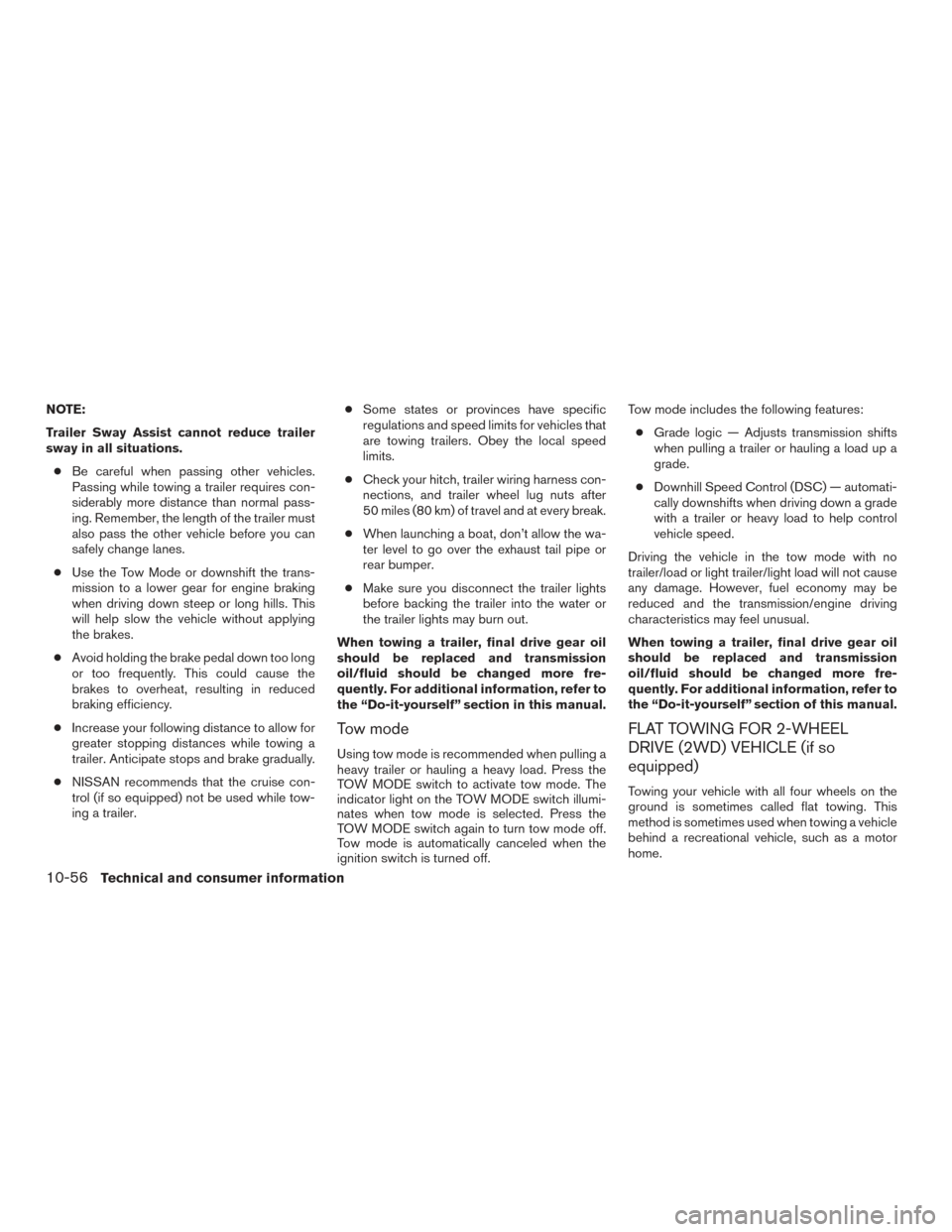
NOTE:
Trailer Sway Assist cannot reduce trailer
sway in all situations.● Be careful when passing other vehicles.
Passing while towing a trailer requires con-
siderably more distance than normal pass-
ing. Remember, the length of the trailer must
also pass the other vehicle before you can
safely change lanes.
● Use the Tow Mode or downshift the trans-
mission to a lower gear for engine braking
when driving down steep or long hills. This
will help slow the vehicle without applying
the brakes.
● Avoid holding the brake pedal down too long
or too frequently. This could cause the
brakes to overheat, resulting in reduced
braking efficiency.
● Increase your following distance to allow for
greater stopping distances while towing a
trailer. Anticipate stops and brake gradually.
● NISSAN recommends that the cruise con-
trol (if so equipped) not be used while tow-
ing a trailer. ●
Some states or provinces have specific
regulations and speed limits for vehicles that
are towing trailers. Obey the local speed
limits.
● Check your hitch, trailer wiring harness con-
nections, and trailer wheel lug nuts after
50 miles (80 km) of travel and at every break.
● When launching a boat, don’t allow the wa-
ter level to go over the exhaust tail pipe or
rear bumper.
● Make sure you disconnect the trailer lights
before backing the trailer into the water or
the trailer lights may burn out.
When towing a trailer, final drive gear oil
should be replaced and transmission
oil/fluid should be changed more fre-
quently. For additional information, refer to
the “Do-it-yourself” section in this manual.
Tow mode
Using tow mode is recommended when pulling a
heavy trailer or hauling a heavy load. Press the
TOW MODE switch to activate tow mode. The
indicator light on the TOW MODE switch illumi-
nates when tow mode is selected. Press the
TOW MODE switch again to turn tow mode off.
Tow mode is automatically canceled when the
ignition switch is turned off. Tow mode includes the following features:
● Grade logic — Adjusts transmission shifts
when pulling a trailer or hauling a load up a
grade.
● Downhill Speed Control (DSC) — automati-
cally downshifts when driving down a grade
with a trailer or heavy load to help control
vehicle speed.
Driving the vehicle in the tow mode with no
trailer/load or light trailer/light load will not cause
any damage. However, fuel economy may be
reduced and the transmission/engine driving
characteristics may feel unusual.
When towing a trailer, final drive gear oil
should be replaced and transmission
oil/fluid should be changed more fre-
quently. For additional information, refer to
the “Do-it-yourself” section of this manual.
FLAT TOWING FOR 2-WHEEL
DRIVE (2WD) VEHICLE (if so
equipped)
Towing your vehicle with all four wheels on the
ground is sometimes called flat towing. This
method is sometimes used when towing a vehicle
behind a recreational vehicle, such as a motor
home.
10-56Technical and consumer information
Page 615 of 671
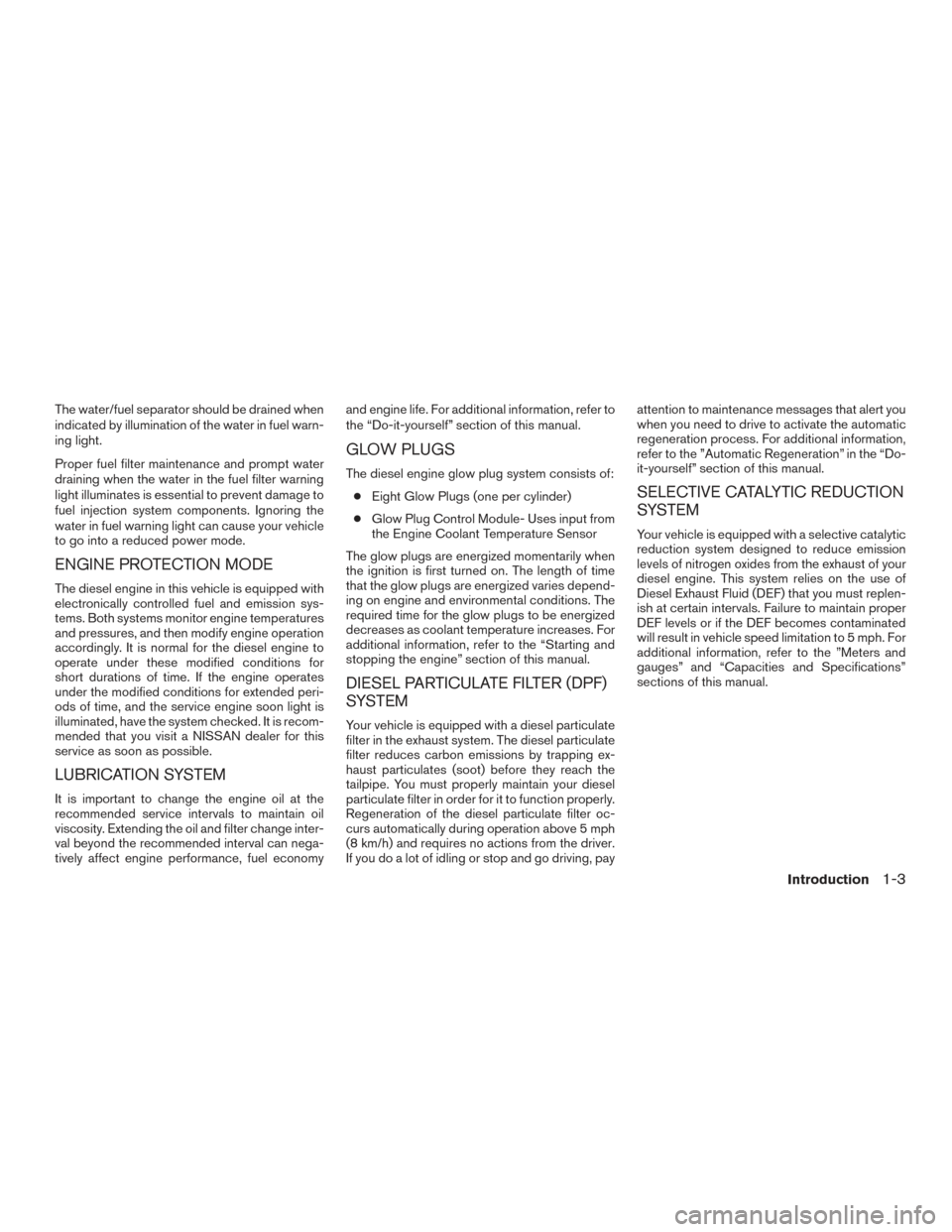
The water/fuel separator should be drained when
indicated by illumination of the water in fuel warn-
ing light.
Proper fuel filter maintenance and prompt water
draining when the water in the fuel filter warning
light illuminates is essential to prevent damage to
fuel injection system components. Ignoring the
water in fuel warning light can cause your vehicle
to go into a reduced power mode.
ENGINE PROTECTION MODE
The diesel engine in this vehicle is equipped with
electronically controlled fuel and emission sys-
tems. Both systems monitor engine temperatures
and pressures, and then modify engine operation
accordingly. It is normal for the diesel engine to
operate under these modified conditions for
short durations of time. If the engine operates
under the modified conditions for extended peri-
ods of time, and the service engine soon light is
illuminated, have the system checked. It is recom-
mended that you visit a NISSAN dealer for this
service as soon as possible.
LUBRICATION SYSTEM
It is important to change the engine oil at the
recommended service intervals to maintain oil
viscosity. Extending the oil and filter change inter-
val beyond the recommended interval can nega-
tively affect engine performance, fuel economyand engine life. For additional information, refer to
the “Do-it-yourself” section of this manual.
GLOW PLUGS
The diesel engine glow plug system consists of:
● Eight Glow Plugs (one per cylinder)
● Glow Plug Control Module- Uses input from
the Engine Coolant Temperature Sensor
The glow plugs are energized momentarily when
the ignition is first turned on. The length of time
that the glow plugs are energized varies depend-
ing on engine and environmental conditions. The
required time for the glow plugs to be energized
decreases as coolant temperature increases. For
additional information, refer to the “Starting and
stopping the engine” section of this manual.
DIESEL PARTICULATE FILTER (DPF)
SYSTEM
Your vehicle is equipped with a diesel particulate
filter in the exhaust system. The diesel particulate
filter reduces carbon emissions by trapping ex-
haust particulates (soot) before they reach the
tailpipe. You must properly maintain your diesel
particulate filter in order for it to function properly.
Regeneration of the diesel particulate filter oc-
curs automatically during operation above 5 mph
(8 km/h) and requires no actions from the driver.
If you do a lot of idling or stop and go driving, pay attention to maintenance messages that alert you
when you need to drive to activate the automatic
regeneration process. For additional information,
refer to the ”Automatic Regeneration” in the “Do-
it-yourself” section of this manual.
SELECTIVE CATALYTIC REDUCTION
SYSTEM
Your vehicle is equipped with a selective catalytic
reduction system designed to reduce emission
levels of nitrogen oxides from the exhaust of your
diesel engine. This system relies on the use of
Diesel Exhaust Fluid (DEF) that you must replen-
ish at certain intervals. Failure to maintain proper
DEF levels or if the DEF becomes contaminated
will result in vehicle speed limitation to 5 mph. For
additional information, refer to the ”Meters and
gauges” and “Capacities and Specifications”
sections of this manual.
Introduction1-3